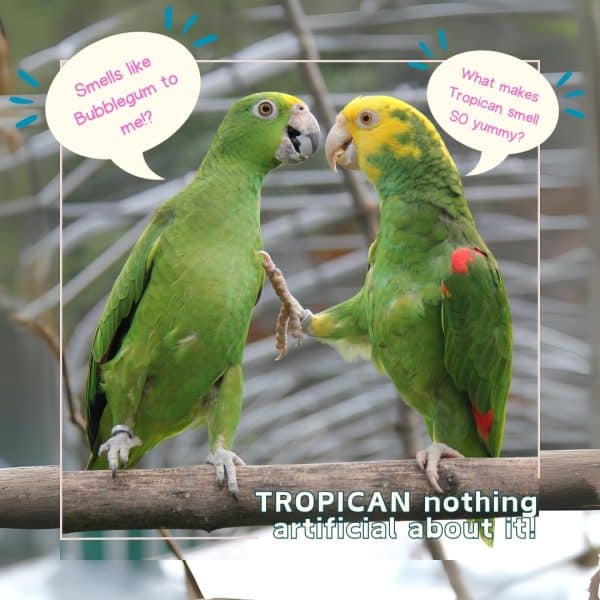Last Updated on by Mitch Rezman
Thanks for speaking with me today.
Here is a list of my birds and the emails from Hagen.
The birds are all breeding pairs: 6 English Budgies, 6 Pacific Parrotlets, 5 Bourke’s, 4 Red Rumps, 4 Eastern Rosellas, 3 Green Cheek Conure’s, 2 White Belly Caiques, and 1 Senegal.
As I mentioned it would be easier for me to have only two diets for these birds.
Whatever help you can be would be appreciated and I look forward to working with you.
Don
In a perfect world, it would be good to keep the 80344 seed mixture separate from the 80524 in order to evaluate what the bird or birds are eating truly. It also minimizes waste, especially with a large flock of birds. BUT, depending on how your flock is caged, i.e. pairs, individual cages, or flocked together, dictates how to feed the combination.
Should you alternate days with the two diets, your smaller birds such as the rosellas etc. really can’t go for more than 36 hours without food, so knowing what the individual bird consumes is paramount. If you are sure that all birds eat formulated diet, you can, by all means, alternate the diet.
The 50/50 suggestion is based on weekly consumption-easy to manage with 1 or 2 birds, but we do understand the challenges associated with flock.
www.windycityparrot.com offers free shipping on orders $49.00 & over. They also have loyalty customer discounts as well.
I hope that helps!
Please feel free to contact me directly should you have further concerns. Sincerely,
Melanie Allen
Avian Product Specialist Rolf C. Hagen (USA) Corp.
melanie.a [email protected]
Toll Free: 888 BY HAGEN (888-294-2436)
www.hagen.com www.hagen.com/hari
Visit the HARI Blog Site! www .hari.ca
Mitch:
Here is a follow-up from Melanie. I received it just after I sent my email to you. If you can digest things and put a plan together for me it would be appreciated. Our birds are in a separate building with heating, air conditioning, and humidity controlled. The smaller birds are in 22D x 22H x 36W Euro Cages and the medium size are in 22D x 22H x 30W cages.
Thanks for your help,
Don
Hi Don!
My answers are in blue.
My birds are in pairs in separate cages. Their cages are good-sized.
Good pairs are easier to monitor in terms of health and diet assessment! “Good size” is arbitrary…I might think a good size cage for your birds is a 10’ X 20’ flight whereas you might be thinking a 24” X 24” X 24” is good. Diet is also based on the calorie burn off….just a thought.
It is my understanding that the smaller pairs would get the 50/50 and my medium size pairs would only get the pelletted diet. Is this correct?
Yes-but let’s be clear and differentiate the smaller and medium and more accurately refer to them by general species.
Smaller-assuming they are the Australian grass keet type species-Rosellas, Red rumps, budgies. Add the parrotlets, despite them being South American, to this too. Their bodies cannot handle high quantities of calories or rich proteins for that matter. In fact, we do make a special Tropican Egg Granule for them…the key ingredient is of course real egg-which offers high QUALITY of protein and not high QUANTITY of protein. 80513 for an 8 lb bag.
Medium-assuming they are the SOUTH AMERICAN and conures-.my suggestions on the diet breakdown that I had sent to customer service for you were based on this separation. The South American birds can handle a different calorie intake than those of the more delicate Australians. For those species, it’s much easier to break down; The HARI recommendation is 70% Tropican /30% Enrichment foods which includes the Tropimix as well as veggies. This way you address their basic nutritional needs without the need for supplements such as Prime.
What would be your feeding program for them?
Australian birds (and parrotlets)
Every day offer the Tropican Lifetime (1 TBSP per bird), and separate dishes offer the Seed mixture-1-2 TBLS per bird. Most of these birds are ground foragers, so use shallow dishes, perhaps with clean natural twigs to encourage the foraging activities. You can sprinkle Prime on fresh, but slightly moistened spray millet or leafy greens once or twice a week. If a particular pair is passing on the Tropican and going for the seed-add an additional day of Prime dose with veggies. Fun ways to get these birds to consume Prime can be found here: http://www.hari.ca/foraging-enrichment-fun-creative-strategies-for-using-prime-efficiently/
Conures pretty much as I had suggested in the previous question. We do have a lot of feeding suggestions from our HARI team on YouTube under the Rolf C. Hagen Channel. Here’s a link to one of them:
They do get veggies several times a week.
Don’t get too carried away with this. Veggies are important, but if the veggie portion is too high compared to essential amino acid sources coupled with proper calorie ratio-you will deprive them of the nutritional foundation and interrupt their bodies’ ability to utilize the minerals and vitamins derived from vegetables.
Best of luck
Melanie
Author Profile
Latest entries
 The Traveling BirdJune 26, 2025Can You Name 5 Parrot Species That Are Living Wild in the USA?
The Traveling BirdJune 26, 2025Can You Name 5 Parrot Species That Are Living Wild in the USA? Bird BehaviorJune 26, 2025How is it Parrots Are Problem Solvers Social Animals and Even Use Tools?
Bird BehaviorJune 26, 2025How is it Parrots Are Problem Solvers Social Animals and Even Use Tools? Bird & Parrot AnatomyJune 25, 2025How a Tiny Chemical Modification Makes Parrots Nature’s Living Paintings
Bird & Parrot AnatomyJune 25, 2025How a Tiny Chemical Modification Makes Parrots Nature’s Living Paintings PigeonsJune 20, 2025How Do Parrots Thrive in Cities Outside Their Native Habitats?
PigeonsJune 20, 2025How Do Parrots Thrive in Cities Outside Their Native Habitats?




